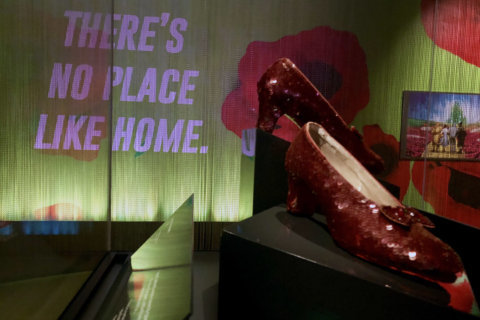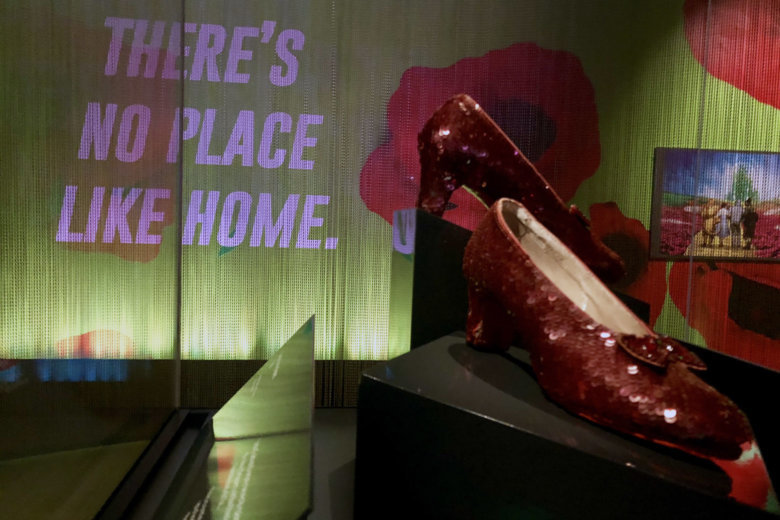
WASHINGTON — There’s no place like home — the Smithsonian — for the Ruby Slippers.
Starting this Friday, Dorothy’s iconic shoes from “The Wizard of Oz” (1939) return to the Smithsonian National Museum of American History in D.C. after an extensive restoration.
“We’re thrilled to have them back on display, looking better than ever,” associate director of curatory affairs Catherine Eagleton told WTOP. “We became worried they needed some love. They were starting to not be ruby anymore and we needed to make sure they were good for the long term. So, we took them off display for about a year and carefully analyzed what they’re made of, how they’re made and worked to stabilize them so they’re looking the best.”
Over the years, the Ruby Slippers have become one of the museum’s most popular exhibits.
“There’s something indelible that still resonates with ‘The Wizard of Oz,’ proven by how many people come to the museum just to see the Ruby Slippers,” entertainment curator Ryan Lintelman told WTOP. “We estimate that tens of millions of people have seen them since they’ve been on display. … Constantly, the carpet’s getting worn out, the glass is getting fogged up, people just want to see them! That joy on people’s faces is what keeps us going.”
How were the shoes originally designed for the 1939 production?
“They’re actually just a commercial pair of shoes that the studio purchased, then they were modified by the costumers,” objects conservator Dawn Wallace told WTOP. “They’re covered in sequins at a really interesting time period because sequins had a gelatin core with cellulose nitrate coating, so it really makes this an interesting part of early plastics. We then have the bow, and although they sparkle like rubies, three different types of glass make up the beads.”
The sparkling red sequins were painstakingly preserved on an individual basis.
“The conservation treatment took over 200 hours, most of that done through microscope,” Wallace said. “I am the conservator who’s had the luck of working on the shoes for over two years. Part of that, outside of the scientific analysis, was actually stabilizing the shoes. It was done on a sequin by sequin sequence. Every sequin was addressed, cleaned of surface dirt, the thread tested for stability, then we were able to realign sequins that had been flipped.”
You’ll also notice felt on the bottom, providing clues as to which scenes they appeared in.
“One of the interesting things about this pair is that there’s felt on the bottom,” Lintelman said. “The Yellow Brick Road was made of plywood, so they didn’t want to hear the sound of her walking down the road. … There were pairs that don’t have felt that were used for the close-ups. … When the house is falling on the Wicked Witch, you can see the bottoms of the shoes, so it’s not this pair. The Academy Museum has the pair that has no felt on the bottom.”
One pair was recently stolen in Minnesota and recovered by the FBI.
“(It) was recently recovered by the FBI with some advice from (our) museum,” Eagleton said. “They were stolen and recovered, and because of the analysis that our conservatism curators have done, confirmed that the stolen pair was the genuine thing. … It was really an exciting moment because people don’t imagine museums helping solve crimes!”
As for the treasured pair at the Smithsonian, they’ve been here in D.C. since the late 1970s.
“They’ve been here since 1979,” Wallace said. “We’ve never had the opportunity to take them off display for very long. This is our first chance to really go in depth into what are the Ruby Slippers, what are they made of and what can we do so future generations can enjoy them.”
Surrounding the slipper display case are several famous quotes from the movie printed on colorful walls: “Pay no attention to that man behind the curation,” “We’re not in Kansas anymore, “There’s no place like home” and “Oh my!” — a reference to lions, tigers and bears.
“Some quotes on the wall are obviously famous quotes from the film, but they’re used in politics, society and culture in other ways,” Lintelman said. “This is what it is to be American.”
It’s all part of a larger exhibit on the third floor of the museum’s west wing.
“It’s a whole floor of exhibits about culture and entertainment,” Eagleton said. “We’ve got the (1923) Yankee ticket booth for baseball fans; an incredible stained glass window featuring Nipper, the ‘His Master’s Voice’ dog; new displays on video gaming; … Stradivarius violins, violas and cellos; … and ‘The Handmaid’s Tale’ costume worn by Elisabeth Moss in the show.”
It’s fitting that the anchoring attraction is the Ruby Slippers, clicked together by Judy Garland in the famous finale of a timeless Hollywood classic that continues to inspire generations.
“Everybody’s had this moment where they dream of going over the rainbow,” Lintelman said. “At some point, they realize that they had this power in them all along, that family matters, that home matters. All of those themes … are what make this so powerful and make us want to watch it every year with our family over the holidays. That’s the thing that keeps this movie alive — people like to watch it together — and that’s what we’re hoping to do at this exhibit.”







